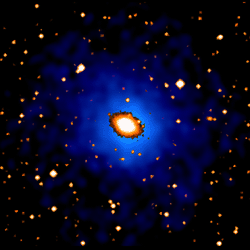X-ray Halos
Most large elliptical galaxies are surrounded by a halo of hot (temperatures anywhere between 1 and 10 million Kelvin), X-ray emitting gas. These galaxies are generally found in groups or clusters of galaxies where the whole region is pervaded by X-ray emitting gas. For this reason, it is not clear whether the X-ray halo around an individual galaxy is associated with the galaxy itself or the group or cluster to which it belongs, and it can be difficult to distinguish where individual X-ray halos end and the intra-cluster medium begins. Although found predominantly around massive elliptical galaxies, weaker X-ray halos have also been detected around starburst galaxies and more recently around spiral galaxies similar to the Milky Way.
The source of the hot gas that creates X-ray halos around individual galaxies is not fully understood, though the following mechanisms are thought to play a role:
- Galactic winds – the hot gas is blown out of the galaxy by evolving stars and supernovae.
- Ram pressure stripping – the hot gas of the galaxy moving within its group or cluster may be removed through interaction with the intra-cluster medium.
- Galaxy strangulation – the hot gas is ‘evaporated’ from the galaxy as it falls into the group or cluster.
The temperature and density of the gas in individual X-ray halos allows astronomers to estimate the mass of the parent galaxy. Estimates of galaxy masses obtained in this way suggest that the luminous matter in galaxies has insufficient mass to account for the total mass detected, and provide strong evidence for the presence of dark matter.
Study Astronomy Online at Swinburne University
All material is © Swinburne University of Technology except where indicated.


